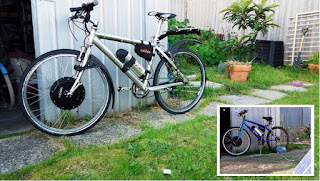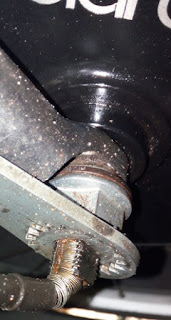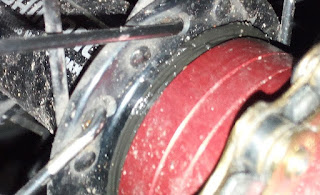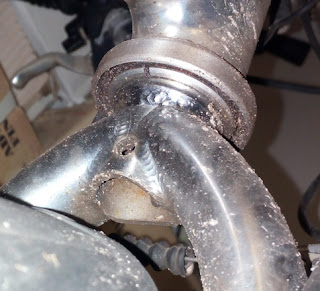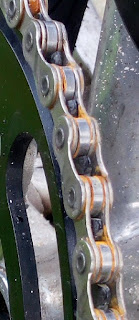After clocking up almost 40,000km since mid-2013 (half of it clocked up in the last 2 years) in my e-Bike to commute to work, here are 2 major lessons learnt:
- Stop water ingress;
- Think about spares requirement.
Photo: Now and then.
There is a huge exponential jump in reliability requirement when I use my eBike as a sole commuting machine. One simply can't afford a major breakdown, and there should be minimal maintenance required even with daily usage (the last thing you want to do is work on your bicycle at the end of daily commute).
Lesson#1: Waterproof Your eBike
Most bicycle components are not designed to be waterproof. These are 5 major components (from most expensive to the least) that need special attention:
Component#1: Battery
I have a tube style battery that is not designed to be water-proof (the big yellow sticker said so). However, who heed the caution tape anyway, right?
So, depending on your battery type, you need to find the gaps where water ingress is possible. On mine, it's the indicator button that tells you the battery charge remaining:
Opening the battery (voids the warranty of course), I applied (very) copious amount of silicon grease (gel type) behind every gap I can find: buttons, screws, switches, etc. To date, it's been proven very effective (true and tested in flooded road and heavy rain).
My second set of battery get silicon gel treatment, whereas my first set didn't get it. On my first set, the water ingress caused the BMS (Battery Management System) developed salt bridge and cut the output off . Luckily, after cleaning the salt bridge, it fixed the problem and continue to serve my machine until it has 70% charge remaining (after 1,000 deep cycles). It's still functioning to today, but not good enough for my commute, as I need at least 80% charge to cover strong head-wind condition (5% time of the year).
Note that I don't mention the controller in this list. Mine hasn't given me any grief whatsoever!
Lesson learnt: Silicon grease gel type is your electronics best friend.
Component#2: Electric drive hub
Considering there are so many different types of electric drives out there, I have to be specific here. I only can give you feedback on my experience with solarbike electric front-drive 500-watt kit (which looks almost identical to any other electric hub kit).
Although the electric motor is not advertised as waterproof, I'm happy to report that by simply applying light oil (I use Inox) on the shaft and cable entry time to time, it has been clocking up more than 30,000km without any issue even in flooded road.
My first front-drive electric hub motor lost its free wheeling after 10,000km. Upon opening the hub, I've found that the stator has rusted and created too much friction between the stator and the rotor. It was hard work to get the rust cleaned off due to the super strong magnet (metal scraper and magnet, hmmm...). However, after cleaning, my first set of motor is back functioning again (I keep this as a spare now).
The bearing is a sealed type on the front motor. Although the interface between the sealed bearing and the axle is a snug fit, it's still not hard to slide through, which I suspect moisture still can seep through this. The cable entry is protected by a putty, but cracks have developed after some time. These 2 factors, my guess, is where the water ingress can get through:
Lesson learnt: light oil as corrosion inhibitor is your wheel hub best friend.
Component#3: non-electric wheel hub
Most wheel hub bearing is not water-proof, unless you have a sealed bearing type. Mine is definitely not (I've learnt this the hard way). Rusty balls anyone?
You definitely can tell when you have water ingress in your wheel hub bearing. Please don't ignore that clanging noise. Walking and dragging a bicycle with a destroyed wheel wasn't a pleasant experience (true story).
After 2 re-grease occasions in the space of 4 months (it's been a really wet 4 months), I've learnt that the best way to block water ingress is to grease them like there's no tomorrow.
From the photo above, you can see the fresh grease oozing out, where other parts are dirty. Ensure to wipe it off time to time as they get flicked off to everything else. Of course, you can get a sealed bearing type. But who can afford them?
Component #4: headset bearing
Remember the fender advice above? Depending on your headset type, water ingress on the headset bearing can cause early failure due to rust.
In mine, there is no protection whatsoever:
So, I have no choice but to grease it like there's no tomorrow. I can't find an aftermarket fender that covers half circle of my front wheel.
Exacerbated with my choice in front wheel drive, my headset bearing needs replacement at least once a year. The headset bearing is definitely not designed to cope with front wheel drive.
If I've chosen rear wheel drive from the very beginning, I wouldn't have this issue. However, there are different issues in choosing rear wheel drive (more on this later).
Component#5: Chain
After trials and errors with different type of grease, light oil, etc, I've found that immersive wax is the very best for longetivity of the chain, coupled with the least number of maintenance.
The basic 'science' is not to have sand and grit trapped in the chain during wet weather riding, which becomes abrasive to your drivetrain (chain ring, the chain itself, and the rear casette). Immersive wax basically makes your chain clean at ALL times (even riding in a flooded road).
However, you still need to dry your chain (quick wipe with a dry cloth) after each wet ride. I left them wet once and ended up with surface rust on the rollers and plates:
I still need to re-wax my chain after cumulative 300km (really) wet ride. In the dry season, I haven't found the upper limit yet. Usually, I rewax after 600km cumulative dry ride (it can definitely go longer).
The other thing I've done to my eBike is to convert it to a single speed. This simplifies the drivetrain considerably for easy cleaning after each wet ride (you don't need gears with eBike). The conversion process itself is a big steep learning curve for me (and not trivial). Let's park that for another time.
To mention the obvious, chain quick-connect is essential.
My last chain has stretched about 1/32" out of 12" length after roughly 10,000km ride (the limit is 1/16" from here
There is another choice: simply replace drivetrain every few months or so. I didn't do any maintenance at one stage (wrong choice of lubricant was also largely responsible) and managed to get a 1/2" stretch (out of 12" length) after more than a year. Yup, the drivetrain was completely destroyed (some teeth were reduced to a blip). Sorted!
Moral of the story: Chain maintenance takes time and money (wax is not cheap). I'm seriously considering the no maintenance approach and treat them as a pure consumables (which includes the chain-ring and rear sprocket).
Lesson#2: Spare Philosophy
Getting cheap parts for your eBike build is one thing, but to keep using it for long term is another thing.
I've seen many special built eBikes entering the market in the last 2 ~ 3 years with its beautifully packaged system (and expensive of course). However, when you need to replace its parts (with components mentioned above). Will these parts available when you need them? How expensive are the replacement parts?
This is when building your own eBike shines. These days, finished products are built to Apple-like system, locking consumer to a specific manufacturer where you can't get replacement parts anywhere else (and super expensive).
On the other hand, using stock standard frame (with special attention to components I mentioned above) ensures your system can last a long time and replaced with cheap available parts when required. New 27.5" and 29-er with disc brakes are not helping one's decision, but, let's park that issue for other times.
I mentioned above that rear wheel drive eliminates the issue with headset bearing (so you don't need to replace it too often). However, from my 40,000 km commuting experience, it has always been (100% of the time) the rear wheel that experiencing punctures (don't know why).
I always have Schwalbe marathon plus with its awesome anti-puncture capability. However, that still doesn't stop steel wire debris (no thanks to industrial area where I need to go) going through the thick layer of rubber.
If I use rear wheel drive and got a puncture, that will be super difficult for me to replace on the road (no such thing as 'Quick Release' on electric motors). I haven't tried tubeless tyres though. So, it might be in the far future when I'm going to experiment with rear wheel drive and tubeless tyres.
Summary:
Knowing what I know now, I would've save at least AUD600 in the last 5 years, i.e. no need to buy a new motor, and less drive train change-out due to less wear and tear.
So far, I clocked up around AUD3,500 in cost (the bulk of the cost are 2 sets of motors and batteries). Predicting my second set of battery will be good for the next 500 cycles, that translates to AUD1.75 cost per trip (6.5cents per km). If I implemented my lesson learnt from the start, that would've brought the cost down to AUD1.45 per trip (5.4cents per km). Not bad!
